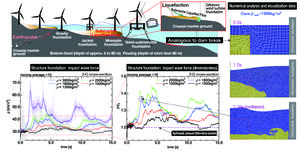Major Research Impact evaluation and nonlinear dynamic simulation of submarine liquefied flow on floating offshore wind turbine and marine structure
The liquefaction and landslides that occur in the seabed due to earthquakes and waves cause severe damage to marine facilities and structures, including broken mooring chains and lost anchors that hold offshore wind turbines in place, collisions among floating structures, destruction of pile foundations, scouring of their surrounding ground, etc. However, no specific technique currently exists in Japan or elsewhere that can evaluate instances of such damage in detail, including the scale and effects of each incidence of damage, frequency of damage occurrence, etc. Therefore, this research project was started with the objective of developing a numerical computation method (particle method: MPS (moving particle simulation)) that can assess the sequence of impact events that are triggered by the sediment flows caused by landslides in the seabed that ultimately affect floating offshore wind turbines and other marine structures’ foundations, and examining the applicability of the simulation model to actual floating wind turbines and other marine structures that will be deployed in the sea. To evaluate the characteristics of submarine liquefied flow, we applied to MPS our numerical model, which is capable of analyzing flow
processes where the effective stress is zero and the structural skeleton of the soil is completely destroyed, based on the experimental data and observation data obtained previously. We also applied the simulation model to mono-pile offshore wind turbines installed in relatively shallow coastal areas to examine how the impact pressure and liquefied ground flow affecting the power plants’ foundations influenced the fluid fields causing sea level changes. These experiments confirmed that the impact pressure affecting the structures’ foundations was significantly influenced not only by the impact pressure of the sediment flow but also by the pressure generated by sea level changes due to disturbances. Furthermore, we verified that the model could accurately estimate the frontal cross-section bordering the liquefied ground and the fluid as well as their two-phase mixture behavior and validated our MPS model’s applicability to the studied phenomena.

Illustration of disaster events triggered by liquefied sediment flow on the seabed
and affecting offshore wind turbines, and other key research findings



